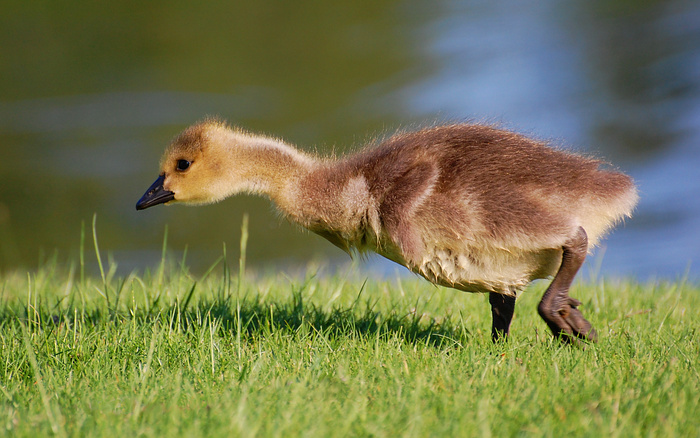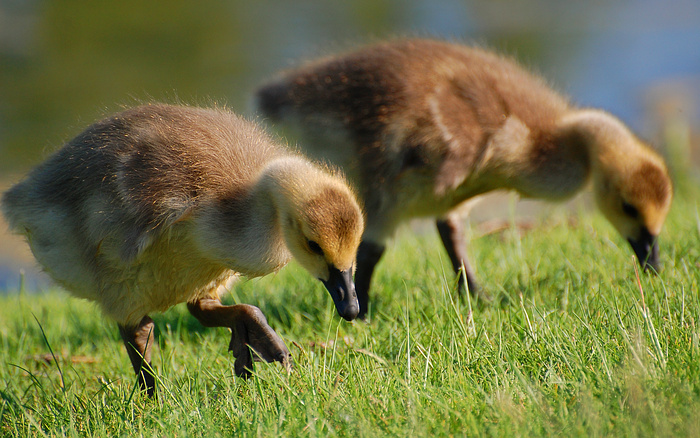
Birding report: Pembroke
October 17th, 2010
Yesterday was spent on a day trip to Pembroke with the OFNC. The group was quite small. The leader hypothesized that since the Trail & Landscape with the trip description only came out very recently, a lot of people probably didn't find out about it until it was too late.
Part one was Lake Doré, which holds the distinction of being the largest lake in North America without islands. It wasn't all I had hoped for, which I think was a matter of luck. There are times it's blanketed with migrant water birds, but yesterday was not one of those times.
It was definitely the most grebey place I've ever been to, though. Grebes are strange-looking water birds superficially similar to ducks, with squat bodies, long necks, and often vividly colored breeding plumage--russet red being a popular color. (An excellent shot of a breeding Eared Grebe is at the top of this page.) For us here in the east, alas, grebes in breeding colors are a rare treat. They mostly breed out west, and unlike male ducks, who lose their colors in late summer but get them back sometime in fall, grebes don't get their colors back until spring. Only the fairly plain-looking (but very cute) Pied-Billed Grebe is regularly seen here in spring and summer. Others, mainly in fall.
Grebes are fish-lovers, which explains why Lake Doré is so attractive to them. At just about every one of our various vantage points, we saw individuals and/or small groups of Horned Grebes. We also saw a few Red-Necked Grebes, which was my first lifer of the day. Other high points on the lake included Common Loons (also now in their winter plumage), Bonaparte's Gulls (the most common gull on the water), and an otter, who was enjoying the abundance of fish about as much as the grebes and loons.
At the picnic area where we had lunch, we were surprised by a flock of Pine Siskins in the treetops. Siskins are northern birds related to goldfinches who sometimes wander south in the winter--perhaps this sighting bodes well for soon seeing siskins in Ottawa? We had a major invasion of them back in winter of 2008/09--I posted pictures then.
Part two was Shaw Woods, a small remnant tract of old-growth forest. This was the more enjoyable part of the day, for me. It wasn't what I expected from old-growth woods: I expected the trees to tower, to be immense, primeval. Not really. No truly huge trunks, and the trees weren't any taller than, say, the white pines at Mud Lake.
What it was was beautiful. Rich fall colors, a diverse mix of trees (birch, beech, aspen, balsam fir, hemlock...), and a cedar swamp that proved to be especially productive for interesting birds. Sightings included a Hermit Thrush, a Winter Wren, and the star of the trip, my first Gray Jay. (Incidentally, that hyperlink's to the surprisingly excellent Wikipedia page for Gray Jay. I recommend it.) Gray Jays are northern birds related to Blue Jays and Crows. They're big, fluffy, and gray and white, like mutant overgrown chickadees. Mostly they stick to the boreal forest and the high mountains. Algonquin Park is the only place at all close to Ottawa where Gray Jays are common. That was where I had expected to get my lifer.
Then I came home and crashed hard. I did this trip on zero sleep but enjoyed it anyway!
Memories Of Goslings
October 10th, 2010

1680x1050 wallpaper

1680x1050 wallpaper
Squelchy
October 9th, 2010
Dear NCC,
I love you guys. I really do. I love Stony Swamp, Mer Bleue, the bike paths, the parks. I love all the hard work you do to protect our greenbelt, our biodiversity.
But if you're going to designate a trail an official trail, please maintain it. "Seasonally wet" should not mean "path cuts through foot-deep beaver pond."
IN OCTOBER.
Bits Of Sunshine
October 3rd, 2010
As the last of the migrating warblers trickle through, I remember the beautiful Yellow Warblers of summer. This is one of the first species to disappear when autumn comes.

1680x1050 wallpaper

The Long Walk
October 2nd, 2010
Wednesday was notable for me in being, I think, the longest hike I've ever done. Certainly the longest uninterrupted hike I've ever done--there were brief stops for the purpose of bird-watching, of course, but no long rests, no meal breaks or snack breaks. Somewhere on the order of 12-13 kilometers. It was good for me psychologically as well as physically. Not to mention the pleasure of extended nature-watching.
The hike took me through Beaver Trail (after a 1.5km hike from the nearest 166 bus stop), Jack Pine Trail, Lime Kiln Trail, and portions of the blue and red Rideau Trails, all within Stony Swamp. Ironically, Jack Pine Trail--considered the creme de la creme of Stony Swamp birding by many--produced exactly zero of the many interesting sightings that day!
Six different species of warblers--Yellow-Rumped, Magnolia, Nashville, Tennessee, Black-Throated Blue and Pine--a little surprising for late September, when warbler migration is supposed to be thinning out. Bands of Golden-Crowned Kinglets everywhere, which was not at all surprising. I was pleased by the tameness of the birds along Lime Kiln Trail (which I'd never been to before). They were foraging low in mixed flocks, and even species I normally expect to be fairly shy, like creepers and warblers, were allowing me close-up views. This is a great place to go if you want to feed birds by hand. Even the Red-Breasted Nuthatches were acting ultra-tame, hovering in front of my face to try to get my attention.
One of the biggest pleasures of the day was a Snowshoe Hare. I see them seldom and it's always a treat when I do. So different from dainty cottontails, as soon as they see me, they tear through the woods at breakneck speed to get away. They're much wilder and much warier.
I'm on a break from photography, so the pictures you'll be seeing in the next week or so (and the ones you've been seeing for the past few days) are all old--though new to you. I seldom process all my photos at the time I take them. A backlog builds up, and so I go sifting through it and pulling out the winners on rainy days.
Little Wood Satyr
October 1st, 2010

1680x1050 wallpaper
Security
September 30th, 2010

1680x1050 wallpaper
Radiant Robin
September 28th, 2010

1680x1050 wallpaper
Rainy day pictures
September 27th, 2010
Some photos that I took back when and didn't get around to posting.

Female Black-Throated Blue Warbler
Photographed in last year's fall migration. The field mark for a female Black-Throated Blue is subtle but a clincher: it's that little whitish spot on her wing. The male, of course, is all field mark!

Viceroy, wallpaper available
The monarch mimic. Real monarchs lack the two lines across the rear wings.
Lesser Yellowlegs
September 26th, 2010
A few pictures of the fall migrant Lesser Yellowlegs at Shirley's Bay last week. The tameness of this species is such a pleasure for photographers.



|
